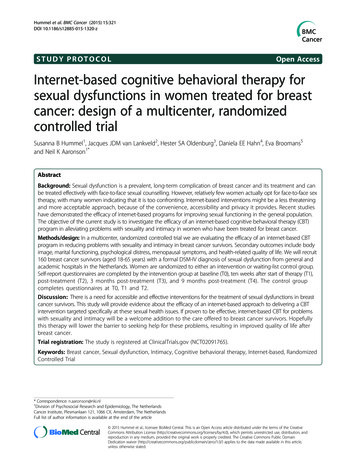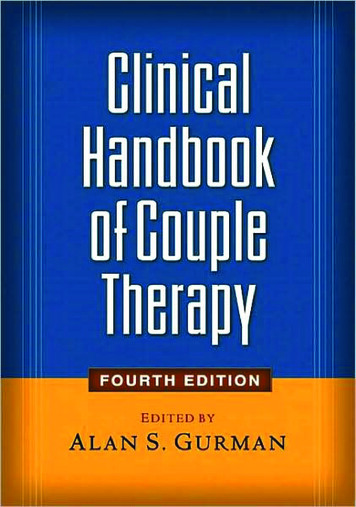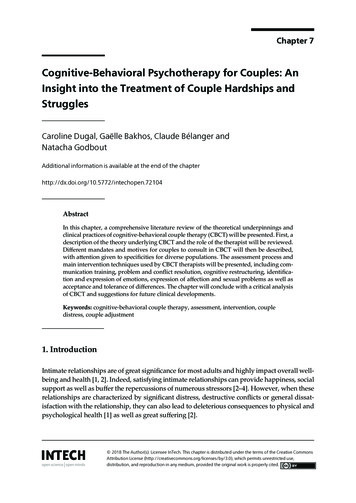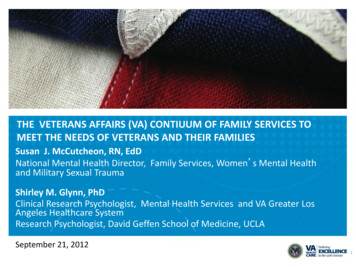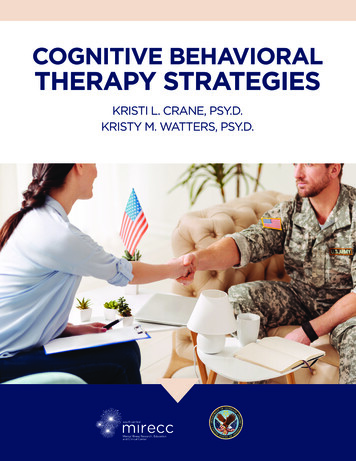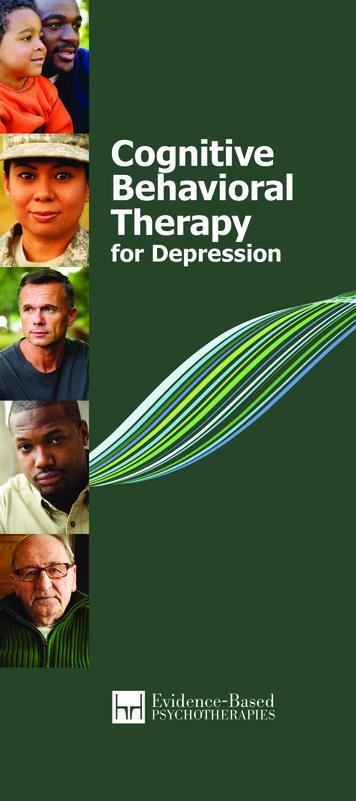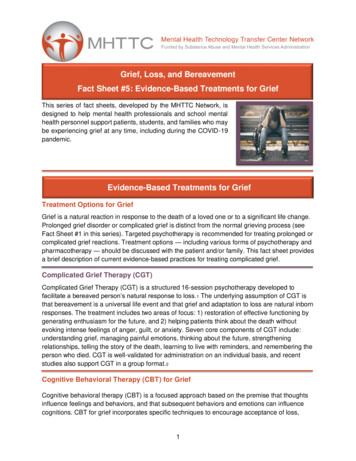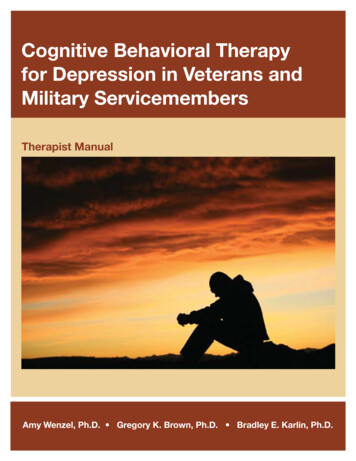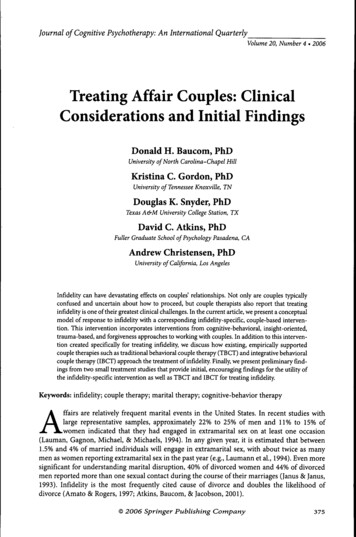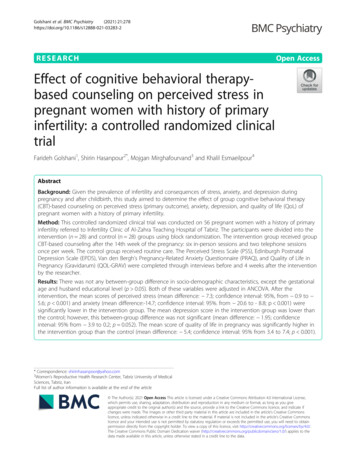
Transcription
Golshani et al. BMC Psychiatry(2021) SEARCHOpen AccessEffect of cognitive behavioral therapybased counseling on perceived stress inpregnant women with history of primaryinfertility: a controlled randomized clinicaltrialFarideh Golshani1, Shirin Hasanpour2*, Mojgan Mirghafourvand3 and Khalil Esmaeilpour4AbstractBackground: Given the prevalence of infertility and consequences of stress, anxiety, and depression duringpregnancy and after childbirth, this study aimed to determine the effect of group cognitive behavioral therapy(CBT)-based counseling on perceived stress (primary outcome), anxiety, depression, and quality of life (QoL) ofpregnant women with a history of primary infertility.Method: This controlled randomized clinical trial was conducted on 56 pregnant women with a history of primaryinfertility referred to Infertility Clinic of Al-Zahra Teaching Hospital of Tabriz. The participants were divided into theintervention (n 28) and control (n 28) groups using block randomization. The intervention group received groupCBT-based counseling after the 14th week of the pregnancy: six in-person sessions and two telephone sessionsonce per week. The control group received routine care. The Perceived Stress Scale (PSS), Edinburgh PostnatalDepression Scale (EPDS), Van den Bergh’s Pregnancy-Related Anxiety Questionnaire (PRAQ), and Quality of Life inPregnancy (Gravidarum) (QOL-GRAV) were completed through interviews before and 4 weeks after the interventionby the researcher.Results: There was not any between-group difference in socio-demographic characteristics, except the gestationalage and husband educational level (p 0.05). Both of these variables were adjusted in ANCOVA. After theintervention, the mean scores of perceived stress (mean difference: 7.3; confidence interval: 95%, from 0.9 to 5.6; p 0.001) and anxiety (mean difference:-14.7; confidence interval: 95%. from 20.6 to - 8.8; p 0.001) weresignificantly lower in the intervention group. The mean depression score in the intervention group was lower thanthe control; however, this between-group difference was not significant (mean difference: 1.95; confidenceinterval: 95% from 3.9 to 0.2; p 0.052). The mean score of quality of life in pregnancy was significantly higher inthe intervention group than the control (mean difference: 5.4; confidence interval: 95% from 3.4 to 7.4; p 0.001).* Correspondence: shirinhasanpoor@yahoo.com2Women’s Reproductive Health Research Center, Tabriz University of MedicalSciences, Tabriz, IranFull list of author information is available at the end of the article The Author(s). 2021 Open Access This article is licensed under a Creative Commons Attribution 4.0 International License,which permits use, sharing, adaptation, distribution and reproduction in any medium or format, as long as you giveappropriate credit to the original author(s) and the source, provide a link to the Creative Commons licence, and indicate ifchanges were made. The images or other third party material in this article are included in the article's Creative Commonslicence, unless indicated otherwise in a credit line to the material. If material is not included in the article's Creative Commonslicence and your intended use is not permitted by statutory regulation or exceeds the permitted use, you will need to obtainpermission directly from the copyright holder. To view a copy of this licence, visit http://creativecommons.org/licenses/by/4.0/.The Creative Commons Public Domain Dedication waiver ) applies to thedata made available in this article, unless otherwise stated in a credit line to the data.
Golshani et al. BMC Psychiatry(2021) 21:278Page 2 of 11Conclusion: CBT counseling can affect the perceived stress, anxiety, and quality of life of pregnant women with ahistory of primary infertility. As a result, this counseling approach is recommended along with other counselingapproaches to improve the mental health of pregnant women with a history of infertility.Trial registration: IRCT Registration Number: IRCT20111219008459N12, registered on 10/11/ 2018.Keywords: Cognitive behavioral counseling, Perceived stress, Depressions, Anxiety, Quality of life, Primary infertilityBackgroundInfertility is defined as the inability to become pregnantafter one year of unprotected coitus [1]. Acording tostudies, about 11 to 51 million people in the world sufferfrom some form of infertility; one in six couples of childbearing age worldwide has this problem [2]. As shown inthe literature, the mean rate of infertility in the world is10% [3]. Female infertility occurs in about 37% of all infertile couples [4]. It ranged from 0.6 to 3.4% for the primary infertility and 8.7 to 32.6% for the secondaryinfertility [5]. In a review study, the prevalence of infertility was reported 17.3% in Iran [3]. The number of infertility treatments is growing and these treatments arestressful for infertile women. The associated psychological pressures and negative behavioral states canthreaten the in vitro fertilization (IVF)/intra cytoplasmsperm injection (ICSI) outcomes [6].Stress is defined as an organism’s total response to environmental demands or pressures which is perceived asa threat to their abilities and resources and endangerstheir health [7]. Stress during pregnancy is related toneonatal delayed motor development, and cognitive andbehavioral disorders. Moreover, it can cause such complications as pregnancy poisoning and spontaneousabortion [8]. Pregnancy-induced anxiety is a strong factor in the prediction of negative outcomes, such as poorfetal development, preterm delivery, low birth weight,and impaired psychomotor development [9]. Depressionis the most common mental disorder during pregnancyperiod [10]. Untreated maternal depression during pregnancy causes growth disorder, low birth weight, pretermdelivery, attention deficit hyperactivity disorder, and fetalarrhythmia [11]. Investigations on the quality of life ofcouples undergoing IVF treatment showed that it waslower in women than in men [12].Different studies have recommended several psychological interventions, including Cognitive BehavioralTherapy (CBT) to improve depression and anxiety [13,14]. CBT helps patients to understand their distortedthinking patterns and dysfunctional behaviors. The basisof CBT is to change the cognitive process. According tothis theory, the experience of behavior alone is not sufficient; rather it is an individual’s interpretation of that experience that causes a psychological disorder. Suchmethods, known as CBT, are used to moderatemisunderstanding and misinterpretation of importantcircumstances of life [15].LoGiudice et al. (2018) performed a systematic reviewto investigate the effect of complementary therapies onpsychological factors in women undergoing IVF and observed their effectiveness in reducing anxiety, depression,and stress, and improving quality of life during pregnancy [16]. Klerk et al. (2005) investigated the effectiveness of psychological counseling on women goingthrough IVF and found no significant between-groupdifference [17]. Hämmerli et al. (2009) failed to show theeffectiveness of psychological interventions in improvingmental health (depression and anxiety) [18]. In LoGiudice review study, the effect of all complementary medicine treatments such as yoga, mind-body techniques andcognitive behavioral therapy on the psychological problems of infertile women undergoing or about to beundergoing IVF cycle, was reported; while the next twostudies only measured the effect of psychological counseling in these women. None of the above studies haveexamined the effect of psychological counseling on themental health of pregnant women following assistedreproduction technologies (ART).Taking into account the anxiety and stress in pregnantwomen with a history of infertility [19], their adverse effects [20], and contradiction in the literature results, thepresent study was conducted to determine the effectiveness of group cognitive behavioral therapy-based counseling on perceived stress (primary outcome), anxiety,depression and quality of life in pregnant women withhistory of primary infertility. The present study developed following hypothesis: CBT counseling reduces perceived stress, anxiety, and depression of pregnantwomen with a history of primary infertility and improvestheir quality of life.MethodResearch design and participantsThis controlled randomized clinical trial was conductedon 56 pregnant women aged between 20 and 40 yearsold with a history of primary infertility referred to Infertility Clinic of Al-Zahra in Tabriz, Iran. Sampling wasconducted from November 2018 to June 2019. Inclusioncriteria were age range between 20 and 40 years, historyof primary infertility, at least secondary school
Golshani et al. BMC Psychiatry(2021) 21:278educational level, and gestational age between 14 to 20weeks. Exclusion criteria were fetal abnormality, selfreported history of mental illnesses, chronic physical diseases and experience of unfortunate events in the past 3months (e.g. relative loss).Sampling and randomizationSampling was initiated after obtaining an ethics codefrom the Ethics Committee of Tabriz University of Medical Sciences (IR.TBZMED.REC.1397.625) and registering the study on the Iranian Registry of Clinical Trials(IRCT20111219008459N12) website. The researcherattended the Al-Zahra Teaching Hospital of Tabriz andextracted the list of women impregnated by assistedreproduction technologies (ART). Then, they were calledand provided with a brief description of research objectives and methodology. Eligibility of the samples wasassessed and eligible women who were willing to participate in the study were invited. In an in-person meeting,research objectives and methodology were completelyexplained. Women impregnated with ART, were interviewed and their Perceived Stress Scale (PSS) was completed by the author. The participants scored higherthan the cut-off point of 21.8 (high level of stress) wereincluded and their informed written consent was obtained. Then, the Postnatal Depression Scale (PDS),Pregnancy-Related Anxiety Questionnaire (PRAQ), andQuality of Life in Pregnancy (QOL-GRAV) were completed by the researcher through interviews.The participants were divided into the interventionand control groups using block randomization withblocks of 4 and 6, based on the age range (20–30 and30–40 years). For allocation concealment, the type ofintervention was written on a piece of paper by a personnot involved in sampling and data analysis. Papers werethen enclosed in specific envelopes numbered sequentially. Each participant received an envelope on arrival.Page 3 of 11counseling sessions, they were entered to the study. Theday before each counseling session, the time of the session was reminded with telephone call and the motivation to participation in the session was strengthenedagain. In case of non-participation of any person in anymeeting, she was invited to another group to hold thesame meeting during the same week, therefore, All 28members of the intervention group completed all counseling sessions. In addition, the counseling was providedin participants’ native language. A brief explanation ofthe content of the sessions is as follows [21]. First session: Inducting, determining the number InterventionThe intervention group, comprised of 5–7 participants,received six 60- to 90-min in-person CBT sessions in aquiet and friendly room in the Infertility Clinic of AlZahra Teaching Hospital and two telephone sessionsonce a week by the researcher. The CBT sessions wasconducted by a graduate student in midwifery counseling under the supervision of a PhD in clinical psychologywho designed the intervention procedure. The intervention was supervised by two person who not involved inthe study approximately once every two weeks randomly. For encouraging the eligible women to participate in the study, the importance of psychotherapy andits role in improving the outcome of pregnancy were explained during the recruitment stage of study and afterconfirming their desire to participate in the study and and duration of each session, sequence of sessionsand group regulations, identifying problem,introducing CBT, introducing cognitive-behavioralpattern, describing the problem based on the givenpattern, determining objectives, and receivingfeedback.Second session: Conducting mood assessment,describing problem based on the given pattern,impacts of lack of control on stress process,determining objectives, introducing progressivemuscle relaxation and practicing it, and allocatinghomework assignments: planning for progressivemuscle relaxation twice per day and receivingfeedback.Third session: Conducting mood assessment,reviewing progressive muscle relaxation, askingparticipants to pose problems, introducingimagination and practicing it (Cognitive imagery is astate in which a person visualizes importantsituations in the mind and mentally anticipatesproblems and obstacles), and allocating homeworkassignments: practicing progressive musclerelaxation and imagination, and receiving feedback.Fourth session: Conducting mood assessment,reviewing imagination practices, introducing threefirst columns of thought record sheet (situation,automatic thoughts, emotions, and mood),introducing hot thought concept, practicing threecolumns (situation, automatic thoughts, emotions,and mood) using one event happened last week, andallocating homework assignments: imaginationtechnique and three first columns of the thoughtrecord sheet, receiving feedback.Fifth session: Conducting mood assessment,conducting discussion about treatment process andits completion, reviewing homework assignments,introducing cognitive distortions, completing threecolumns of thought record sheet (situation,automatic thoughts, emotions, and mood),identifying hot thought, introducing the concept ofhot thought challenge, and determining homework
Golshani et al. BMC Psychiatry(2021) 21:278assignments: relaxation technique and recordingthree columns of the thought record sheet(situation, automatic thoughts, emotions, and mood)and receiving feedback. Sixth session: Conducting mood assessment,reviewing homework assignments, introducingchallenge with thoughts and 7-column thought record sheet (situation, automatic thoughts, emotionsand mood, confirmatory evidence, rejective evidence,alternative thought, and re-assessment), completingcolumns during the session, introducing the conceptof hot thought challenge, allocating homework assignments: recording three first columns of thethough record sheet and relaxation techniques, receiving feedback. Seventh session: Conducting mood assessment,reviewing homework assignments, completing sevencolumns of the thought record sheet during thesession (situation, automatic thoughts, emotions andmoods, confirmatory evidence, rejective evidence,alternative thought, and re-assessment), and allocating homework assignments: completing 7-columnthought record sheet and relaxation techniques, receiving feedback. Eighth session: Conducting mood assessment,reviewing homework assignments, reviewing thetreatment process (reviewing and recording differentCBT techniques), taking recurrence preventionprocess, introducing self-management sessions andits scheduling, and allocating homework assignments: self-management session and determinationof the precise date of post-test.The control group only received routine pregnancycare based on the “National Guideline for Midwifery andDelivery Services” of Iran [22]. Four weeks after theintervention, the posttest PSS, EPDS, PRAQ, and QOLGRAV were completed by the author for both groupsvia a telephone call.Data collection toolsData were collected using the socio-demographic andmidwifery scale, Cohen’s perceived stress scale, PRAQ,EPDS, QOL-GRAV.The socio-demographic and midwifery questionnairewas prepared by the authors and its validity was confirmed by 10 academic members of Tabriz University ofMedical Sciences.Page 4 of 11score indicated a higher degree of stress. The internalconsistency and reliability coefficients were obtainedthrough Cronbach’s alpha in a range of 0.84–0.86 in twogroups of students and a group of tobacco users in asmoking cessation program [23]. The reliability of theFarsi version was calculated by Bastani et al., using theinternal consistency method and the Cronbach’s alphaof 0.74 was obtained [24].Van Den Burgh’s pregnancy-related anxiety questionnaireThe shortened version of the PRAQ (PRAQ-17) whichwas used to measure the anxiety level (secondary outcome), contains 17 items and the score of each itemranges between 1 and 7. Therefore, the total PRAQscore is between 17 and 119. The higher total PRAQscore indicates a higher level of anxiety [25].The Edinburgh postnatal depression scaleThis scale is used to measure the level of depression(secondary outcome) during pregnancy and postpartum.Items are scored from 0 to 3 based on the severity ofsymptoms. An individual’s score is the total sum of all10 items, which varies between 0 and 30. Mothers whoscored higher than the threshold level [12] had differentlevels of depression [26]. In the present study, suchmothers were referred to a psychologist.Quality of life in pregnancy (Gravidarum) (QOL-GRAV)questionnaireThis questionnaire was developed by Vachkova et al.(2013) using the WHO Quality of Life-BREF (WHOQOL-BREF). It is composed of 9 items to measure individuals’ experience of the quality of life duringpregnancy (secondary outcome). The QOL-GRAV’sscore varies between 9 and 63. Higher scores indicate ahigher quality of life [27]. Mirghafoorvand et al. indicated acceptable validity and reliability of the questionnaire [28].In the present study, the reliability of the questionnairewas determined through test-retest on 20 women in atwo-week interval and the Cronbach’s alpha and intraclass correlation coefficient (ICC) was determined. TheICC for PSS, PRAQ, EPDS, and QOL-GRAV was 0.91,0.88, 0.83, and 0.93, respectively. The Cronbach’s alphafor these questionnaires was 0.87, 0.78, 0.72, and 0.91,respectively.Existence of any adverse event after the interventionwas asked from participants as an open question aftercompleting the post-test questionnaires.Cohen’s perceived stress scaleThe degree of stress (primary outcome) was measuredusing PSS-14. The scale is scored based on a 5-pointLikert scale; the lowest and highest scores are 0 and 56,respectively. The cut-off point was 21.8 and a higherStatistical analysisAfter collecting data from all participants, they were analyzed in SPSS-21. The normality of the quantitativedata was determined using the Kolmogorov-Smirnov
Golshani et al. BMC Psychiatry(2021) 21:278Test and all variables were normal. The chi-square test,Trend chi-square test, Fisher’s exact test, and independent t-test were used to assess the consistency of sociodemographic data. The independent t-test was used tocompare the two groups before intervention in terms ofperceived stress, anxiety, depression, and quality of life.After the completion of the intervention, this comparison was conducted using the analysis of covariance(ANCOVA) while controlling the baseline values andthe effect size was calculated based on this formula:Cohen’s d (M2 - M1) / SDpooled. All analyses were donebased on intention-to treat.Sample size estimation in G-Power was 24 pergroup based on the study by Hassan-Zadeh Lifshagerd[29], considering m1 35.2 (mean score of perceivedstress), and presumed stress score reduction by 15%after the intervention (m2 29.92; sd1 sd2 4.87;two-sided α 0.05; power 95%). The final samplesize was 28 considering the probable sample loss ofabout 15%.Fig. 1 Flow chart of the studyPage 5 of 11ResultsAt the beginning of the study, 150 women with positivepregnancy test results were contacted. Finally, 94 womenwere excluded based on eligibility criteria. The researchinstruments were completed for the remaining women(n 56) and they were equally randomized into counseling and control groups. Because the participants weremotivated enough by the researcher, all 28 participantsof the intervention group completed all counseling sessions, they also did their homework in more than 90% ofthe cases. Due to premature birth, two participants inthe counseling group and three participants in the control group were excluded. As a result, the postintervention follow-up analysis was conducted with 26participants in the counseling group and 25 participantsin the control group (Fig. 1).The comparison of socio-demographic characteristicsof participants in study groups was shown in Table 1.There was no significant between-group difference insocio-demographic data, except gestational age and
Golshani et al. BMC Psychiatry(2021) 21:278Page 6 of 11Table 1 Socio-demographic characteristics of participants in study groupsCharacteristicCounseling (n 28)number (%)Control (n 28) number (%)P-valueAge (years) *31.8 (5.85)31.1 (5.3)0.668†Husband’s age (years) *37.1 (7.2)36.1 (5.0)0.551†Duration of infertility (years) *8.1 (5.2)7.5 (4.5)0.663†Gestational age (years) *15.9 (2.4)17.1 (2.6)0.046†0.515††Causes of InfertilityFor men21 (75.0)23 (82.1)Feminine7 (25.0)5 (17.9)0.240‡Level of educationSecondary school3 (10.7)9(32.1)High school4 (14.3)2(7.1)Diploma11 (39.3)8(28.6)University10 ployed7(25.0)2(7.1)0.034‡Husband’s Secondary school3(10.7)5(17.9)High 1(39.3)9(32.1)0.265§Husband’s 3(10.7)1(3.6)0.752‡Monthly income Relatively adequate15(53.6)19(67.9)0.310§House oman’s parents’ house1(3.6)0(0)Husband’s parents’ house5(17.9)7(25.0)0.440‡Life 7.1)3(10.7)Unsatisfied1(3.6)2(7.1)Having a history of domestic violence0(0)0(0)Frequency of treatment failure0.823‡
Golshani et al. BMC Psychiatry(2021) 21:278Page 7 of 11Table 1 Socio-demographic characteristics of participants in study groups (Continued)CharacteristicCounseling (n 28)number (%)Control (n 28) number (%)Zero5(17.9)4(14.3)One7(25.0)6(21.4)Twice and more18(64.2)16(67.)P-value*mean(SD)§Fisher’s exact test†Independent t-test††Chi-square test‡Trend Chi-square testhusband educational attainment (Table 1). However, bothvariables were moderated using the ANCOVA (p 0.05).The independent t-test showed no significant betweengroup differences of the total perceived stress score beforeintervention (p 0.561). Based on the ANCOVA and adjusted baseline values, the mean standard deviation ofthe total perceived stress score was significantly lower inthe counseling group than that of control group afterintervention (mean difference 7.3; confidence intervalof 95%: from 0.9 to 5.6; p 0.001) (Table 2), corresponding to a large effect size (2.48).The independent t-test showed no significantbetween-group differences of total anxiety score beforeintervention (p 0.484), whereas based on the ANCOVAand adjusted baseline values, the mean standard deviation of total anxiety score was significantly lower in thecounseling group than that of control group after intervention (mean difference 14.7; confidence interval of95%: from 20.6 to 8.8; p 0.001) (Table 2), corresponding to a large effect size (1.43).The independent t-test showed no significantbetween-group differences of total depression scorebefore intervention (p 0.495). After intervention, basedon the ANCOVA and adjusted baseline values, themean standard deviation of depression was lower inthe counseling group than that of control group; however, this between-group difference was not significant(mean difference 1.95; confidence interval of 95%:from 3.9 to 0.2; p 0.052) (Table 2), corresponding toa medium effect size (0.51).The independent t-test showed no significantbetween-group differences of total quality of life scorebefore intervention (p 0.833). After intervention basedon the ANCOVA and adjusted baseline values, themean standard deviation of the total quality of lifescore was significantly higher in the counseling groupthan that of control group (mean difference 5.4; confidence interval of 95%: from 3.4 to 7.4; p 0.001) (Table2), corresponding to a large effect size (1.8).No adverse events were reported by participants.DiscussionResults from this study showed that the mean perceivedstress and anxiety scores were significantly lower in theTable 2 Comparison of mean perceived stress score of anxiety, depression and quality of life in the Study GroupsVariableCounseling groupmean (SD)Control groupmean (SD)Mean difference (95% confidence interval)P-valuePerceived stress score (score: 0 to 56)Before intervention46.5 (2.6)46.8 (2.4) 0.4 ( 1.7 to 0.95)⁎4 weeks after intervention38.9 (3.9)46.6 (2.2) 7.3 ( 9.0 to 5.6)†63.2 (11.9)65.6 (13.8) 2.4 ( 9.3 to 4.5)⁎561/0001/0 Anxiety Score: (Score: 17 to 119)Before intervention484/048.0 (9.6)63.9 (12.4) 14.7 ( 20.6 to 8.8)†Before intervention16.2 (4.7)17.0 (4.2) .82 ( 3.2 to 1.6)⁎4 weeks after intervention13.1 (3.2)15.3 (5.3) 1.95 ( 3.9 to 0.2)†25.7 (3.1)25.5 (4.4)0.21 ( 1.8 to 2.2)4 weeks after intervention001/0 Depression Score (score: 0 to 30)495/0052/0Quality of Life Score (score: 9 to 63)Before intervention4 weeks after intervention31.5 (3.1)25.8 (3.2)5.4 (3.4 to 7.4)⁎833/0†001/0 ⁎ Independent t-test† ANCOVA with baseline score control and gestational age and spouse education variablesBefore intervention, the number of participants in the counseling group was 28 and in the control group was 28, and after the intervention in the counselinggroup was 26 and in the control group was 25
Golshani et al. BMC Psychiatry(2021) 21:278counseling group than the control 4 weeks after intervention. The mean depression score was lower in thecontrol group 4 weeks after intervention with adjustedbaseline values; however, this between-group differencewas not significant. Moreover, the mean quality of lifescore was significantly higher in the counseling groupthan the control.In a review study, Ying et al. (2016) investigated the effect of psychological interventions on mental health,pregnancy rate, and marital function of infertile couplesundergoing IVF. In 20 trials under investigation, 14 interventions, such as CBT, mindfulness, counseling, coping with stress, and positive reassessment used atdifferent IVF stages were studied. The authors concluded that none of these interventions were effective insoothing stress and depression of patients undergoingIVF [30]. Results from the above study were inconsistentwith the present study, which could be attributed to thefollowing reasons. The present study investigated theuse of CBT on pregnant women with history of primaryinfertility; whereas, Ying et al. implemented interventions during the course of treatment. Moreover, none ofthe reviews investigated the psychological outcomes ofintervention in the two-week wait period, despite thefact that this period is one of the most difficult times inthe life of infertile couples.Given that stress perception and responding to it areaffected by previous experiences, the present situationand learned behaviors [31], it could be concluded thatthe CBT counseling in which new thinking and behaviortechniques are taught to replace negative thoughts of patients about self, world, and future [32, 33], are helpfulin identifying stressful situations and using coping strategies. The correction of cognitive assessments, improvement of coping skills, and combination of practices tointegrate learned techniques with real-life situations canreduce the level of stress [29].Hamzeh Poor (2014) showed that anxiety in infertilewomen was significantly lower in the CBT group thanthe control [34]. Findings of the present study were consistent with those of the above study. However, HamzehPoor investigated the participants from the initial treatment to the intrauterine insemination (IUI) stage, i.e. before getting positive pregnancy result. In a quasiexperimental study, Salehi (2016) compared the effectiveness of group CBT and interactive lecturing (IL) inreducing anxiety in pregnancy. Results showed a significant reduction in the state and trait anxiety in CBT andIL groups after 4 weeks (p 0.001). In addition, groupCBT was more effective than interactive lectures in reducing participants anxiety; however, this betweengroup difference was not significant (p 0.05) [35]. Results from the above study were consistent with the findings of the present study; however, there was aPage 8 of 11difference between two studies in the number of counseling sessions and participants.In a review and meta-analysis study, Golshani et al.(2020) examined the effect of cognitive-behavioral therapy on anxiety and depression in Iranian infertile womenand concluded that the level of anxiety in infertilewomen who received cognitive-behavioral therapy compared to the control group was significantly lower (P 0.001); But it had no significant effect on depression[36]. The results of the above study are consistent withthe present study. Abdolahi et al. (2019) in a metaanalysis study examined the effect of cognitivebehavioral therapy on anxiety and depression in infertilewomen infertile women with or without IVF / ICSI andconcluded that cognitive-behavioral therapy leads to asignificant reduction in anxiety (P 0.001) and Depression (P 0.001) in the counseling group compared to thecontrol group [37]. The results of the above study areconsistent with our study in terms of the effect of counseling on anxiety, but do not agree with our
couples undergoing IVF treatment showed that it was lower in women than in men [12]. Different studies have recommended several psycho-logical interventions, including Cognitive Behavioral Therapy (CBT) to improve depression and anxiety [13, 14]. CBT helps patients to understand their distort
